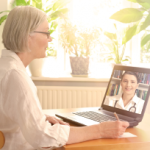Educational Implications
Telemedicine will be less personal, less hands-on than traditional patient encounters. One can foresee problems recruiting bright, creative, humanistic students to a mode of practice centered on data entry and managing numbers, and devoid of in-depth relationships with vulnerable patients.
Questions also arise about how we can provide ambulatory education in such an environment and how trainees can master cognitive and clinical skills, as well as patient advocacy absent a live patient.
This mode of practice seems to be fertile ground for burnout. These matters will be particularly germane in facilities where deferred expenditures on needed technology in outpatient clinics have occurred, let alone for the video cameras required for telehealth, to say nothing of technology access problems on the patient’s side.
Social & Fairness Implications
Telemedicine risks widening healthcare disparities. The extreme model of concierge practice offers a limited number of privileged patients able to pay an annual retainer a choice of live or telemedicine visits, which are promptly arranged. One can foresee that for those with less robust insurance a claim will be made that telemedicine is better than nothing. The question is how much better than nothing? New quality metrics will be needed to prove or disprove that claim.
Face-to-face patient encounters could become the exception, with routinized, impersonal telehealth visits the new normal. Are we unwittingly changing the role of physicians to one more analogous to “your call is important to us,” semi-anonymous, customer service representatives?
Healthcare disparities will be aggravated by disparities in patient access to higher quality technology hardware and software platforms. In our inner-city, safety net practice, telehealth visits typically involve older patients whose main link to our practice entails telephone land lines without the capacity for video contact. For patients who are not fluent in English, telemedicine adds an additional obstacle to the personal medical care they need. The evaluation and management of pediatric patients and patients with visual, speech, hearing or cognitive impairments will be challenging in a remote format where direct observation and interaction are not possible.
Finally, more broadly and philosophically, will telemedicine enhance or undermine the importance of solidarity and mutual human obligations, recognition of our universal vulnerability to disease and mortality if increasingly it surrenders to the atomization and anomie that make human community less common? In the age of shopping remotely from home and on-demand movies and entertainment in place of going to theaters, will we be the enablers of, or the resistance to, the social isolation that undermines a sense of community, mutuality and solidarity? Will medicine be episodically personal and predominantly remote, or will that which is uniquely professional and relational in the clinical encounter survive?
How these questions are answered will shape the future of the doctor-patient relationship.



